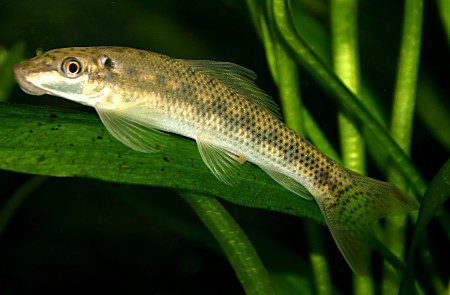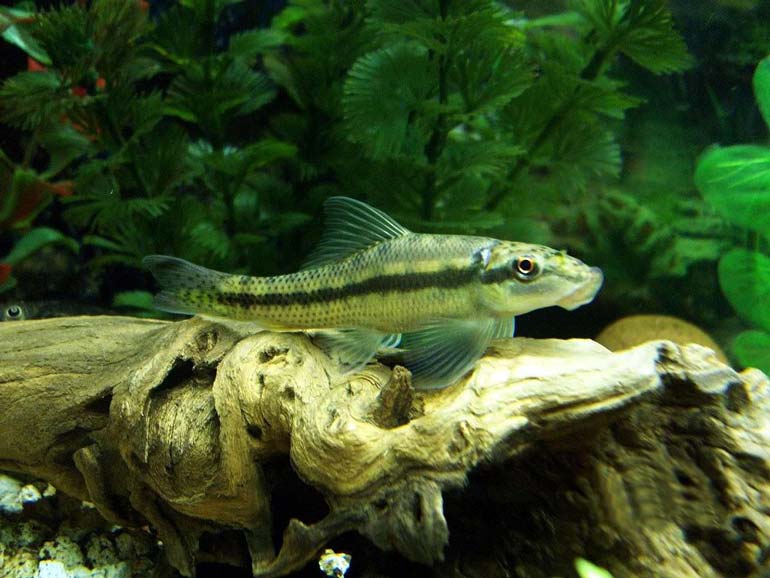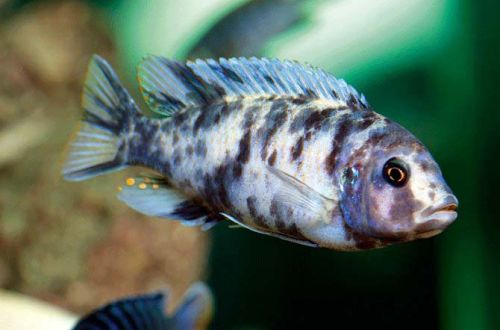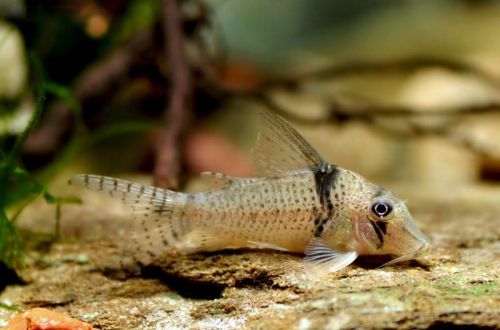
Chinese algae eater
Chinese algae eater or Gyrinocheilus golden, scientific name Gyrinocheilus aymonieri, belongs to the family Gyrinocheilidae. The fish does not differ in its original appearance, and in China it is completely used as food. However, the unique feature of clearing the aquarium of unwanted algae makes it in demand among many aquarists. The best choice for co-keeping with bright views, some decorate the aquarium, others keep it clean, while remaining discreet.

The fish has several common names, among them a derivative of the Latin name, Gyrinocheilus, common among Russian-language publications.
Requirements and conditions:
- The volume of the aquarium – from 200 liters.
- Temperature – 25-28°C
- pH value – 6.0 – 8.0
- Water hardness – soft to medium hard (5-19 dH)
- Substrate type – soft sand, large smooth stones
- Lighting – preferably bright
- Brackish water – no
- Water movement – moderate, can be strong
- Size – up to 13 cm.
- Food – mainly plant foods, algae
- Life expectancy – up to 10 years
Contents
Habitat
Girinocheilus golden was first described in 1883, the fish is common in many areas of Southeast Asia and southern China. Since the 50s, it has been exported to Europe as an aquarium fish, while in their homeland they are eaten.
The fish lives in large and medium-sized rivers, as well as on flooded plains during the rainy seasons, often found in well-lit small streams and reservoirs where algae grow rapidly. The algae eater, with the help of its sucker-like mouth, absorbs periphyton (a mixture of algae, small bacteria and detritus), adults do not refuse zooplankton and small insect larvae.
Description

The fish has an elongated body 12–13 cm long. A characteristic feature is the mouth in the form of a suction cup, around which there are several small tubercles or “spikes”, this structure is ideal for attaching to the surface, especially in fast moving water.
The color of the fish is variable, more often individuals with yellowish sides and a dark back are found, a dark line / stripe runs all over the body from head to tail. The stripe can turn into a series of black spots. There are several morphological forms that differ in color: golden, marble, albino.
Food
Young fish are exclusively vegetarian, eating algae and plant foods such as spinach leaves or lettuce, a piece of cucumber, zucchini, dry industrial plant food will do. The amount of food supplied depends on the amount of algae in the aquarium, if there are a lot of them (clusters of algae are noticeable on the walls and decoration), then there is no need for additional nutrition. In the case when the aquarium is clean and even signs of algae are imperceptible, then the fish has completely eaten them and needs to be supplemented from outside.
As they grow older, the diet begins to change, the Algae Eater begins to require protein foods such as brine shrimp, daphnia, bloodworms, frozen food pieces, this type of food should be combined with plant foods. When the fish lacks meat products, it can stick to its tankmates, eating the protective mucus from the body.
Maintenance and care
The fish needs a high oxygen content in the water and the creation of an artificial current, this is easily achieved using a productive filter combined with an aerator. Since the Chinese algae eater mainly lives in the bottom layers, regular (every two weeks) cleaning of the substrate will avoid possible poisoning by organic decomposition products. During cleaning with a siphon, you should not clean decoration items (rocks, driftwood, etc.), they form a biological film, which is also food for your pet.
The design of the aquarium is recommended to be brought closer to the natural habitat – thickets of plants, soft sand and pieces of rocks or large smooth stones scattered all over the bottom, you can create several caves, shelters. Since algae is an essential part of the fish diet, it is desirable to provide bright light for their rapid growth, but this is not a prerequisite.
Social behavior
Young are peaceful and suitable for all types of fish, but with age their behavior changes, the fish becomes territorial and begins to attack tank neighbors. The problem is solved by the content in the group of at least 5 individuals, the internal hierarchy reduces aggression towards other species. With adult fish, it is recommended to keep active species that live mainly in the upper parts of the water, and can also be kept with African cichlids.
Sexual differences
The male differs from the female in the presence of a large number of tubercles or “thorns” around the mouth, which are especially prominent during the spawning period.
Breeding / breeding
In home aquaria, breeding is difficult and there are very few successful experiments, they are random.
Diseases
The fish are sensitive to the drugs used in community tanks and are easily tolerated by most species. There may be problems with digestion after eating the protective mucus of other fish around the aquarium. For more information about fish diseases and their treatment, see the section “Diseases of aquarium fish”.
Features
- Becomes aggressive when kept alone
- Requires plant food
- Possible jumping out of the aquarium
- Requires high oxygen content





